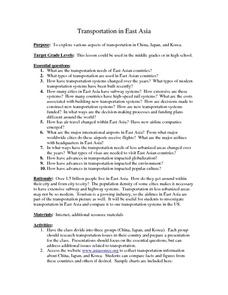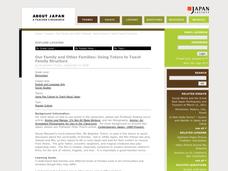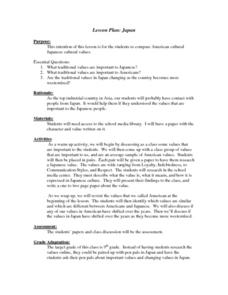Curated OER
Tanabata: The Japanese "Wish Upon a Star"Festival
Students research the legend of Tanabata in order to explain some of the astronomical findings in the night sky. The Japanese tell the story in order to explain the origin of celestial bodies.
Dick Blick Art Materials
Simple Suminagashi
Go ahead. Spill the ink! Combine the study of art, social studies, and science with a Suminagashi (spilled ink) activity that produces "unique and unreproducible" works of art.
Curated OER
Simple Texts for Primary Pupils
Can literacy get any more fun than this? Learners not only have fun, but gain confidence as well when presented with familiar text in another language. Select books, songs, poems, even recipes written in another language, and using the...
Curated OER
Teaching Numbers with Primary Pupils
One, two, three. Un, deux, trois. Eins, zwei, drei. Primary learners love to count and this activity contains a series of games that encourage learners to count in English, French, German, and Spanish. The exercises develop literacy and...
Curated OER
Memory Games
Researchers say that we need to hear and see new language 12 times before we remember it! Here's a plan that details a series of games that can be used as memory exercises. Bingo, Noughts and Crosses, Pelmanism, and repetitive speaking...
Curated OER
Sadako and the Thousand Paper Cranes
Have your class explore the effects of war by reading Eleanor Coerr's story, "Sadako and the Thousand Paper Cranes." This is a story about a sixth grader who lives in Hiroshima when the atomic bomb is dropped. Learners answer questions,...
Curated OER
The Olympic Dream: East Asia
Learners engage in research in order to establish a context for comprehending the historical event of the Olympic Games being held in China. They use the internet and other resources to find information.
Curated OER
New Year Celebrations in Korea
Students investigate the New Year's holiday looking at the American tradition in comparison to Korea. This helps to point out the qualities of the holiday for those who live in Korea.
Curated OER
Teaching About Peace Through the Cranes of Hiroshima
Students listen to the story of "Sadako and the Thousand Paper Cranes." They discuss the events of Hiroshima, effects of the bombing, and methods people can make a difference in achieving peace in the world. Students use orgami paper and...
Curated OER
The Tale of the Mandarin Ducks
High schoolers are introduced to the time of the samurai warriors using the guided reading of "The Tale of the Mandarin Ducks". The teacher reads the story to the students and they make connections from the text about the history of the...
Curated OER
Social Studies: Bombing of Hiroshima
Students read a first person account of the bombing of Hiroshima written by a Japanese physician. By reading Michihiko Hachiya's journal, they discover the fatalities caused by the bomb itself and later by radiation poisoning. To...
Curated OER
GRAVE OF THE FIREFLIES
Students engage in a video activity to research the effects of war upon the Japanese to live in the world after World War II. They answer specific questions in order to complete the unit.
Asian Art Museum
Defining "Home"
Open-ended dialogue and guiding questions lead children through a discussion about the relationship between physical objects and personal identity. They analyze the work of two contemporary Japanese artists who have use their mediums to...
Asian Art Museum
Japanese Architecture for Elementary School Students
Art and architecture go hand-in-hand. Kids watch clips from the Hayo Miyazaki film Spirited Away to better understand Japanese customs and architecture. The discussion questions included are very good, and will help you lead the class in...
Curated OER
Kodomo No Hi: Children's Day Celebration
Children's Day is a beloved Japanese holiday with many colorful and engaging traditions. On this national holiday celebrated yearly on May 5, children are honored for their strengths and given good wishes for happiness. Your younger...
Curated OER
What's the Weather Like? Primary Level
Elementary schoolers and language learners will shine with a series of games and activities that feature weather words. The exercises can be adapted for pairs, small groups, or whole class participation.
Denver Art Museum
Alien Beauty
"Beauty is in the eye of the beholder," is a popular phrase in our society. The instructional activity here puts the phrase to the test as pupils explore what truly is beautiful through a study of some Japanese folk art. A careful...
Curated OER
Transportation in East Asia
Learners engage in research about the subject of transportation in Eastern Asia. The size of countries and population pose challenges that are studied and reflected upon in student writings from the information found.
Japan Society
Our Family and Other Families: Using Totoro to Teach Family Structure
What do families around the world have in common? Explore this theme through the popular animated film My Neighbor Totoro by Hayao Miyazaki. Over the course of two days, pupils view the film, pausing to discuss their own families and the...
Curated OER
East Asia & The World
Students discuss the relationships between East Asia and the United States. They examine the importance of trade and politics. They examine graphs and charts of certain aspects of the region and discuss.
Curated OER
Being in the Noh: An Introduction to Japanese Noh Plays
Students read a Japanese Noh play and discuss its structure and traditional characters. They choose a short myth and write a Noh play based on it.
Curated OER
Korea's Literary Tradition
Students read a text about Korea's literary tradition. In this literary tradition lesson, students read the multiple page text to learn about Korea's literary tradition.
Curated OER
Manga and Me
Upper elementary and middle school learners study Manga cartooning and create a Japanese character based on their own features and personalities. This style of cartooning is easily-accessible for most young scholars. With a little...
Curated OER
Japanese and American Values
Ninth graders compare and contrast the values that Americans and Japanese people deem as important. They use the internet and the school media center to find the information in order to answer research based questions.























